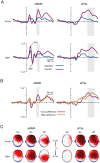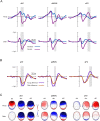Automatic auditory and somatosensory brain responses in relation to cognitive abilities and physical fitness in older adults
- PMID: 29057924
- PMCID: PMC5651800
- DOI: 10.1038/s41598-017-14139-9
Automatic auditory and somatosensory brain responses in relation to cognitive abilities and physical fitness in older adults
Abstract
In normal ageing, structural and functional changes in the brain lead to an altered processing of sensory stimuli and to changes in cognitive functions. The link between changes in sensory processing and cognition is not well understood, but physical fitness is suggested to be beneficial for both. We recorded event-related potentials to somatosensory and auditory stimuli in a passive change detection paradigm from 81 older and 38 young women and investigated their associations with cognitive performance. In older adults also associations to physical fitness were studied. The somatosensory mismatch response was attenuated in older adults and it associated with executive functions. Somatosensory P3a did not show group differences, but in older adults, it associated with physical fitness. Auditory N1 and P2 responses to repetitive stimuli were larger in amplitude in older than in young adults. There were no group differences in the auditory mismatch negativity, but it associated with working memory capacity in young but not in older adults. Our results indicate that in ageing, changes in stimulus encoding and deviance detection are observable in electrophysiological responses to task-irrelevant somatosensory and auditory stimuli, and the higher somatosensory response amplitudes are associated with better executive functions and physical fitness.
Conflict of interest statement
The authors declare that the research was conducted in the absence of any commercial or financial relationships that could be construed as a potential conflict of interest.
Figures


References
Publication types
MeSH terms
LinkOut - more resources
Full Text Sources
Other Literature Sources
Medical
Molecular Biology Databases

